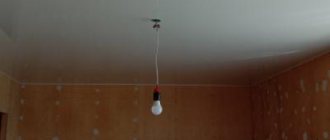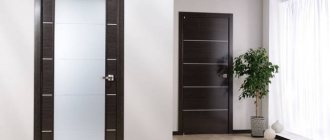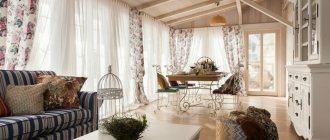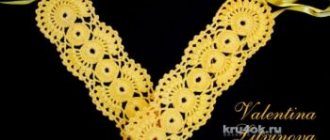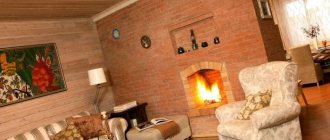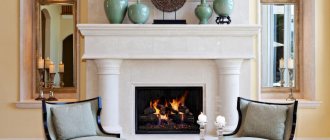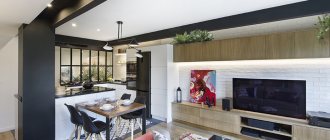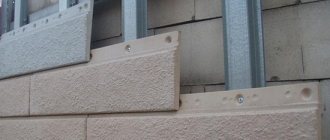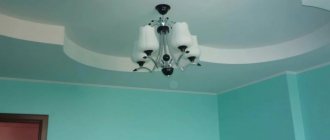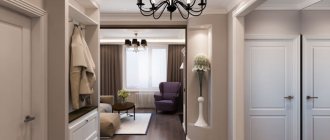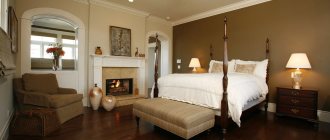Distinctive features of the loft style
The loft style (from the English loft “attic”) arose naturally against the backdrop of the Great Depression of the 30s in the United States. Due to the economic crisis in the country, industrial enterprises went bankrupt one after another, and empty factory buildings were rented out. Artists loved them because of the abundance of light and space. But since there was no money for repairs, the interior was left as is - ceilings, walls and floors without finishing, communications in a visible place. Then the workshops began to settle down.
Private housing in an industrial premises - this is how one phrase can explain the essence of this style. Loft is easy to recognize by its characteristic features:
- unfinished walls made of brick or concrete (later version);
- open communications, ventilation pipes;
- high ceilings and huge windows;
- combining several functional areas into a common space, even without partitions;
- horizontal rooms;
- mixing old and new, antiques, handmade - poor residents used everything they could get their hands on in the interior.
The Great Depression passed, and the style was firmly entrenched in modern interior design. It can be reproduced both in a residential building and in an apartment.
Loft is not as simple as it might seem at first glance. When decorating an interior, beginners make mistakes that result in the loss of chic and aristocracy:
- cheap brick tiles - the cladding should look natural, picturesque, like real masonry;
- low ceiling - this problem is often encountered when decorating rooms in Soviet-style houses; in spacious production workshops the walls are always high;
- an abundance of dark shades greatly narrows the space, especially in small rooms such as a bathroom; the absence of bright colors in the interior takes away coziness and comfort, so designers recommend using several bright accents.
Loft-style ceiling: 5 affordable ideas
The loft style implies an extremely unusual combination of simplicity and luxury at first glance. In the most paradoxical loft style, seemingly multidirectional and contradictory things are combined. Combining rough, clumsy finishing with elegant sophistication and minimalist grace, combining simplicity with luxury - breaks the stereotypical vision of design preferences and forces you to look at home comfort and familiar principles in the interior in a new way. Fundamental details in the loft style are most often not sophisticated designs. This applies primarily to ceilings and walls.
Content:
The Loft direction was not formed artificially, but as a result of the style and lifestyle of creative people. The Great Depression of the 30s of the XX century, which hit industrialists and entrepreneurs, caused the bankruptcy of most factories and factories. The abandoned manufactories of America with their spacious workshops became favorite objects of creative and free people, who turned industrial premises into living and working studios.
Loft style is created using:
- Unfinished walls;
- Open communications;
- High ceilings;
- Open plan with a minimum number of partitions;
- Large windows to the floor;
- Mezzanine (mezzanine, which is created within the main floor);
- A mix of industrial elements with antiques and modern technology.
A loft-style ceiling is, first of all, maximum simplicity of finishing and open communications
A true loft is created only from industrial areas that have a history, but you can safely stylize the interior in this direction using characteristic elements. Modern materials make it possible to realize the dream of a spacious and rebellious loft even in ordinary apartment buildings.
A spacious room, characteristic of a loft, is created by the maximum combination of adjacent rooms. The effect of an abandoned industrial area is reproduced thanks to the brickwork and properly designed ceiling. Designers in loft interiors give preference to wood, concrete, and metal.
Loft ceiling design stylized in modern interiors
Basic loft design structures, such as ceilings and walls, are characterized by a restrained and sparse color scheme. White and gray tones, shades of brown and black, the presence of metal and chrome parts. A ceiling with a loft style can be the main design element.
For loft ceiling styling you can use:
- Concrete covering;
- Ceiling tiles with patterns, which are used in offices;
- Stretch ceilings with suitable film;
- Metal mesh;
- Decorative false beams;
- Metal partitions and pipes imitating industrial pipes and communications.
Please note that the loft style is best suited for spacious rooms with high ceilings
The loft concept assumes an open plan, so the design of zones is carried out with ceiling decoration, for example, beams.
Brick wall decoration in a loft style can be combined with suspended ceiling systems. Matte and glossy PVC coatings are suitable for modern loft design: white film, dark brown, beige, steel film, etc. For greater originality, the photo printing technique is suitable. A stretch ceiling system stylized as brickwork or concrete covering will fit perfectly into the loft atmosphere.
The only drawback of decorating a loft ceiling with a tension covering: the loft style requires free spaces and high ceilings, which does not always meet the standards of multi-storey apartments, and tension systems additionally reduce the ceiling height.
Original concrete loft style ceiling
The most effective way to emphasize the industrial style is concrete coatings. Concrete is considered a universal, environmentally friendly and durable material that is suitable for pouring ceilings, creating columns, furniture, and partitions. If previously a concrete ceiling indicated the beginning of renovation, now it is one of the decorative techniques that is gaining momentum in popularity.
Loft ceilings are characterized by unplastered surfaces, often even bare concrete
Rules for using concrete on the ceiling:
- Moderation and dosage. If a loft atmosphere is created in a small room, then it is advisable to use concrete in fragments.
- Compatibility with walls. Concrete ceiling surfaces look great with wood in warm shades, glass elements, and brick trim.
- Proper processing. Concrete, being a cold, rough and ascetic material, needs a subtle and careful approach.
If the room is no higher than three meters in height, then the concrete ceiling covering should be combined with darker walls.
Correct loft ceiling design with concrete material
If the concrete ceiling is “native” to the room, then it is polished and coated with special products. If the house is brick, then the exposed concrete ceiling can be imitated.
To simulate concrete I use:
- Microcement;
- Decorative panel;
- Architectural concrete.
Microcement with architectural concrete will create the same effect of a cement screed with characteristic color transitions and a pleasant “suede” texture.
Before applying materials imitating concrete, the ceiling must be treated as before painting.
An untreated concrete ceiling looks aesthetically unattractive, and due to its roughness, it quickly becomes dirty and ages. Modern tools make it possible to process concrete with high quality, after which the coating acquires marble smoothness and shine.
It is advisable to sand the concrete ceiling and coat it with a special compound
The benefits of polishing a concrete ceiling are:
- Spectacular appearance of the surface, which resembles a marble or polymer ceiling;
- Strength and surface hardness;
- Possibility of using a variety of color shades for surface finishing;
- Financial accessibility of this processing method.
Stages of polishing a concrete surface:
- Milling;
- Grinding;
- Application of a special mixture.
For each stage of processing, a special tool is used. A milling machine opens deep pores of the concrete surface, cuts off large sagging and bumps, but does not remove wave-like differences. The milling stage leaves grooves in the concrete up to 4 mm deep, which are removed by grinding.
Using a grinding machine with diamond or corundum coating, small irregularities are removed from the concrete, the surface is cleaned of cement laitance, which prevents the penetration of polishing mixtures into the surface of the concrete.
The first stages of work are carried out with dry concrete. For final processing, the surface is coated with a special varnish mixture.
Interior design in loft style (video)
The industrial loft theme is stylized using versatility. The variety of photos with loft interiors is proof of this. Rough and cold brutality, exposed structures are combined with soft home comfort and warm tones, creating an atmosphere of freedom and originality. Creative people, with the help of loft style, embody their most original ideas, accentuate and emphasize, at first glance, shortcomings and turn them not just into advantages, but into new fashion trends. The main task of the style is the ability to combine industrial rough details in such a way as to create an atmosphere of freedom and purity.
Ceiling design in loft style (photo)
homeli.ru
Lighting and backlighting
Different types of lighting will have completely different results. Spotlights can be mounted in the crossbars or between them in the ceiling.
For complex volumetric structures, mobile lamps can be attached directly to the beams and change their position if necessary.
The chandelier should reflect the overall stylistic idea, for example, in a country style room it could be a low wrought iron chandelier, while in a Provence interior it could be neat with several textile shades.
An unusual effect is created by the LED strip; recessing it into the side parts of the beam creates a feeling of floating in the air.
Concrete for walls and ceilings
The use of modern technologies in creating an interior, as well as a number of tricks, will allow you not only to decorate the room with a concrete mixture, but to obtain a non-standard decorative coating. Thus, the brutality of concrete walls turns into an ultra-fashionable gloss, reflecting all the colors of the interior with skillful handling of the material. The line from pure concrete to polished walls is much thinner than it might seem at first glance. By properly treating a concrete surface with modern coatings, you can not only create an unusual design object, but create a masterpiece.
Room design with concrete ceiling
White room with concrete ceiling
Interior of a room with a concrete ceiling
Concrete ceiling in the interior of the room
Concrete ceiling
Application options in interior design
The introduction of advanced technologies in the development of interior decoration makes it possible not only to decorate a building with a concrete consistency, but also to obtain an unusual decorative coating. Thus, the mercilessness of concrete walls is transformed into a prestigious shine, reflecting all the colors of the interior when the material is expertly processed.
Now there is something to cover a concrete ceiling, and the treatment is simple. By conscientiously decorating a concrete surface, you can get an unusual design object. The majority of advanced dwellings have concrete inclusions, and the ceiling is often made from this material.
For modern living spaces, this is one of the best options, especially for the loft style. But thanks to the emergence of new materials in the interior, it is more common to use not concrete itself, but its imitation, which is much cheaper and more convenient. Surfaces in different rooms are covered in this way.
Natural concrete
Concrete is a pre-processed material, but in the last few years it has been used for interior design and finishing. The untreated plane has an unusual appearance. It looks good in urban and industrial style.
Treated concrete
The concrete ceiling in the interior can be processed in different ways, choosing the optimal look for the building.
The process is carried out in this way:
- The seams between the slabs are covered to increase interfloor sound insulation.
- They can prime, cover the surface with impregnations or varnishes to protect it from dust and cracks. These compounds fix the concrete and make it possible to carry out wet cleaning.
- The ceiling is tinted without hiding the texture of the concrete in order to reduce the roughness of the coating. For this purpose, lime or water-based paint is used.
Imitation concrete
If the surface of natural concrete does not arouse interest, but at the same time you want to preserve the special industrial style of the apartment, you can use an imitation of the material.
In this case, use the following surfaces for a concrete ceiling in the interior:
- Modular slabs. They are hung on the ceiling and do not require further decoration. Fastening is carried out using metal fasteners or by gluing. The slabs are suitable for installation on suspended ceilings. Color and texture are presented in a wide range.
- Special textured paints for the home. They contain mineral additives and transformative preparations that help ensure a special distribution of paint pigments throughout the entire surface. The result is unevenness and areas of varying tones, giving the illusion of a wet or dry cement slab. Immediately after application, you can touch the paint layer with a putty knife to create streaks, indentations and other imperfections.
- Decorative plaster allows you to simulate a special plane close to reality. The plaster is applied in a thick layer, including creating an imitation of joints between the slabs on the plane. You can also imitate cracks and prints, if required by the project.
You can treat the damp surface with a sponge using original movements to make the ceiling surface rough. Using different tools, it's easy to achieve any style. After all the steps, a top layer of varnish or wax is applied to the ceiling.
Metal with concrete
The use of steel in home interiors is another modern trend. With the help of perforated sheets, a complex ceiling geometry is created, in which the main place, of course, is allocated to concrete.
A good option is to use forged parts. They are used to make partitions that zone space, shelving and bar counters. The combination of brutality with perfectly smooth parquet floors gives maximum effect.
In studio-type apartments, it is advisable to perform zoning using a steel mesh. Additionally, ceiling cornices are fixed near it, on which blind or, on the contrary, transparent silk or velvet curtains are hung. With their help, you can isolate a separate part of the apartment.
Nothing will stop a bachelor from building a toilet from glass, completely transparent panels, matted at the touch of a button.
When working on the interior of a small apartment, you should observe moderation. Here it is permissible to use only one accent element that unites the entire room and creates the required mood.
The most successful options for the kitchen
The use of decorative plasters for kitchens takes into account the location of the plastered areas. Some types of putties are only suitable for finishing walls throughout the kitchen. Others - to serve as a huge wall panel. Still others are for improving the apron in the niche of the kitchen unit. Almost all are suitable for organizing room zoning.
You can highlight the dining area and visually expand the room using a light marble or art-concrete covering. Silicate wood or smooth stone finishes will truly enrich the kitchen space. It is suitable for interiors in Baroque, Classical, Rococo, Italian, English styles.
Yellow silicate decorative plaster will make the kitchen environment sunny and joyfulSource gidpokraske.ru
For kitchens in a classic style, Italian or even laconic high-tech, coatings that imitate marble, granite chips or cold natural stone are often selected. Silk plaster will fit very well into the interior of boho-chic, Provence and any other neoclassical style.
Marble plaster on kitchen wallsSource pro100stroy.com
Types of successful decorative plasters based on textures and colors for finishing kitchen walls:
- marble – polished or matte surface;
- silk – dark, light, with mother-of-pearl;
- wood imitation;
- under brickwork;
- “travertine” texture;
- under wood;
- “bark beetle” texture;
- orange peel texture;
- “sea wave” texture;
- stucco or volumetric sgraffito.
The most reliable in strength and safest to use is mineral decorative putty. It will never fade in the sun, it is difficult to scratch it with a knife or chip it with an accidental blow. You need to wash without using hard brushes or abrasives. Small particles of bulk detergents can become lodged in the finely porous structure.
Texture – “brickwork” with imitation whitewash Source petro-man.ru
Plaster finishing under whitewashed brickwork will look great in a Provence, chalet, light country, loft, or Scandinavian style interior. Simplicity and texture will serve as an excellent backdrop for furniture and various decorative items (paintings, floor hangers, chairs, open wall shelves, large lamps hanging directly from the ceiling, lamps).
Textured plaster in the form of cinder block masonry for a chalet-style kitchen interiorSource window-kursk.rf
“Travertine” resembles porous-relief natural stone or weathered “shell rock” (building blocks made from compressed shells). Such imitations are often created in light shades. The darkest shades for such surfaces are blue-gray, light green or light brown.
Travertine will ideally create an imitation surface of natural stoneSource mykaleidoscope.ru
Textured coating “bark beetle” is considered one of the most fashionable today. And a surface plastered to look like wood is always a popular technique and fits most interior styles. This technique will be cheaper than decorating the room with a real array. The technique suits almost every interior if you treat the wall with putty with a surface similar to an orange peel. Any shades are already applicable here.
Types of decorative plaster that are not suitable for finishing kitchen walls:
- Acrylic.
- Silicate.
- Silicone.
- With crocodile skin design.
Acrylic mixtures are dangerous to apply on walls near hot stoves and heating radiators. When heated, the high molecular weight polymer will emit harmful toxic volatile impurities. When exposed to intense sunlight, it cracks. Another disadvantage is the low degree of vapor permeability.
For the kitchen, acrylic plaster is best used to decorate the wall of the dining area, where there are no nearby heat sourcesSource s.sakh.com
The silicate mixture is not harmful to human health and could well be used for finishing kitchens. But it's inconvenient to apply
Before using this decorative paste, it is important to pre-treat the wall surface with a special primer
In the interior, using silicate plaster you can achieve beautiful textured coatings Source avatars.mds.yandex.net
Textured crocodile leather finish is not suitable for every interior style
It is better to take it into account after careful consideration during the development of the project. The texture is interesting, but labor-intensive to apply
It should only be done by a professional.
Decorative plaster “under crocodile skin” close-upSource na12.ru
Factors on which the decor of the living room depends
The use of different materials is allowed. Among them:
- Decorative plaster. It will help hide noticeable unevenness of the walls. The material is expensive, but is considered durable and can be renewed annually by painting. When used correctly, it does not turn yellow or fade (if the color version is used).
- Liquid wallpaper. They contain acrylic and lie flat on the surface. This option is affordable and environmentally friendly, and does not require professional finishing skills. The disadvantage of this material is the lack of assortment. In total, there are five to seven types of mixture for application.
- Paper wallpaper. An excellent budget option that is suitable for those living rooms in which the walls are perfectly straight. The canvases are easily soiled and cannot be cleaned and are subject to mechanical stress. Gluing is not easy, as the paper often tears and wrinkles.
- Vinyl or non-woven wallpaper. This option has a wide range of colors, but the base is considered not environmentally friendly. It may take a long time for the smell from the wallpaper to dissipate and not harm a person’s lungs. Among the advantages are that it fits perfectly on the surface, dries quickly and has a lot of colors. With the help of such finishing you can even create a basis for decoration.
- Painting. Quite a good option, especially if wallpaper for painting is already pasted. It applies well with a roller and leaves no drips or streaks. These properties are guaranteed if the instructions for dilution and use of the liquid composition are followed.
- Wall panels are options of different shapes and textures. They also differ in color. They are expensive and not widely available. Suitable for all types of walls, they hide sound insulation and other intermediate materials well. The panels do not tolerate temperature changes and mechanical damage. Due to the high cost, they try to mount it on one wall to create an accent or depth of the room.
- Textile wallpaper. These are pure and natural canvases. They will create a unique atmosphere in a classic interior style. Not practical as they get dirty easily. They are expensive, but when completed, the rooms look rich, luxurious and perfect.
Space is an important factor when choosing decor. The smaller the living room space, the less visible accessories and decorations should be.
Using coffee textile wallpaper with textureSource oooalfa-pro.ru
Decorating the walls in the living room with bright textile wallpaperSource mirpola-dekora.com.ua
Painting a concrete ceiling
This option is also more affordable, like the first, but compared to the previous one, it has some advantages: a variety of colors, a better composition and good wear resistance. With the help of such a rich palette you can create interesting designs for apartments and houses. It can be matte or glossy. Matte looks appropriate in modern design (high-tech, loft, minimalism). Glossy requires a perfectly flat ceiling and will look better in a classic or baroque interior.
The peculiarity of painting the ceiling is that all work must be done quickly
To work, you will need to buy paint for interior work. It is divided according to its chemical composition into:
- acrylic;
- latex;
- silicone,
- silicate
Acrylic paint is most popular for its practical properties:
- rich palette;
- does not fade from the sun, does not change shade;
- penetrates into small cracks and masks them (up to 1 mm);
- easy to clean and not washable;
- lies flat;
- durable;
- inexpensive in cost;
- has no odor;
- non-toxic;
- applicable to any surface.
Acrylic paint is truly durable, but only if all the requirements for working with it are met: proper surface preparation, following the instructions when diluting and applying. Basically, two coats are required to achieve the desired color saturation.
Acrylic paint is very durable
Latex paint, like acrylic, consists of rubber, but only of a synthetic nature. Latex paint is richer and can be used in just one coat. It has the same positive properties as its previous brother.
Latex paints are less resistant to low temperatures, so their use is advisable for well-heated rooms.
The general disadvantage of the listed paint options is that they are susceptible to the formation of fungus even despite their moisture-resistant qualities. Modern, improved products on the shelves promise protection against this disease thanks to the addition of special components. Practice shows that this does not add much to their effectiveness. You still have to prime the surface before each coat.
Silicone paints are considered improved in this regard. They tolerate large temperature changes, high humidity, and are resistant to fungus and mold. Combining all the advantages of the options already listed, silicone paint has one drawback - high price.
Silicate paints will be an excellent solution for decorating ceilings in the bathroom, kitchen, and swimming pool. Of all the options, they are the most durable, moisture-resistant, dirt-repellent, and antiseptic. The products are slightly toxic and require additional protection when working with them.
You can also find unusual types of paints on the market: textured, embossed, textured. They are made on the basis of aqueous acrylic dispersion and marble chips. In terms of quality characteristics, it is not inferior to other popular types. You can create interesting designs with them. Not everyone can afford them. The price is quite high.
To paint a concrete ceiling, it is important to choose the right tool:
- special sprayer;
- brush;
- roller
It is best to use several devices at once.
The correct solution would be to use several devices at the same time. Use a brush to carefully paint corners and areas near the wall. At a short distance from the wall they use a small roller; for a larger area they work with a larger tool. To prevent the paint from splashing too much (it is very difficult to wash off), you should hold the rollers at an angle of about 45 degrees and do not press too hard.
For convenience, special nets are pulled to squeeze out the rollers. This allows you to avoid excess dirt and apply the paint evenly.
The same rules apply to brushes. Apply the product, lightly squeezing out the excess.
A special sprayer - an electric spray gun - is more difficult to use. Before starting work, you need to study the instructions. The paint is diluted to a certain thickness. You constantly need to monitor the location of the tool. It should always be at the same distance.
The peculiarity of painting the ceiling is that all work must be done quickly. Modern paints are made to dry quickly for practical reasons. In this case, the master is required to have good skills in finishing work.
The question of how to paint a concrete ceiling so that the coating lasts for more than one year is solved by observing all stages of preparation for work.
- removal of old paint, whitewash, etc.;
- polymer primer treatment;
- putty;
- polishing with sandpaper for perfect alignment;
- re-priming;
- painting;
- Applying a second coat (if necessary).
You can often come across statements that a more or less even ceiling does not need to be puttied before painting. But the point is not even a flat surface, but the fact that the paint in this case will not last long, even if there are no visible flaws.
Lighting and additional decorative elements
This style widely uses materials such as wood, glass, and metal. It is from them that you can choose a lot of interesting accessories.
The most popular decorative option is wooden beams, slats, channels and panels that act as supporting structures. Beams placed not at right angles, but in broken lines, and metal mesh, especially those painted in contrasting colors to the ceiling, look interesting. Steel and copper fittings add more brutality. To save money, they install not original materials, but polyurethane dummies. Vintage fans with blades are appropriate in high rooms.
A concrete ceiling looks elegant, in the center of which there is a rosette with a geometric or floral pattern, especially in the dining area in the kitchen. It makes sense to put a round table under it.
Large-mesh metal meshes, including chain-link, air ducts made of shiny stainless steel, etc., will add a deliberate roughness. Bicycles can be stored in them in plain sight. This option is suitable for children and teenagers.
A harsh loft ceiling will be given lightness and warmth by lighting. Several lighting options are used:
- chandeliers in an industrial style, reminiscent of industrial devices - irregular in original shape, rough in color, or even assembled from individual lamps without a lampshade;
- suspended ceiling lamps - all kinds of spots look original here, with domed, oval, semicircular shades, devices in the form of fans;
- LED strips - for hidden lighting.
Lighting fixtures are chosen with large or elongated bulbs. Lampshades are preferable to copper or steel, chrome-plated. Bulb lamps on cords also came into fashion.
In low rooms, a contour LED strip at the top of the wall will visually raise the ceiling. You can install a chandelier above the table and illuminate the rest of the room with hidden fixtures.
Fabric elements add coziness - textiles on the sofa and windows, carpet on the floor. But without classic curtains, it is better to install blinds.
Varieties by composition
Wall finishing material fillers have different features, functional and technical properties. If this is an option for decorating surfaces with gypsum or lime, then you can safely count on their strength. Such mixtures are usually used to finish the ceiling between beams in interior styles: Provence, country, chalet, vintage, retro, loft. Or when plastering sections of walls to look antique.
Decorative plaster in eco-style living room interiorSource behance.net
Additional additives for decoration, creating an unusual coating:
- metallized threads;
- crushed shells;
- large cellulose fibers;
- pigments and colors.
Any decorative marble plaster in the living room, dining room, or hallway will not only beautifully recreate a beautiful pearlescent-shiny surface, but will also reliably protect the walls from various aggressive external factors. Neither mechanical damage, nor chemicals or detergents will damage the integrity of the coating. A number of other types of additives to plaster have the same or different properties.
Glossy marble plaster on the walls of the living roomSource odnastroyka.ru
Acrylic
Acrylic and latex decorative bases have ideal vapor permeability and durable operation. The strength is comparable to materials where gypsum is added to the composition. They are well suited for interior decoration of rooms such as kitchens or bathrooms. The texture is smooth, the walls are easy to clean from dirt.
External cladding of house facades is also done using plasters with such additives. The main advantage is that the walls “breathe” and are resistant to mechanical damage, rainy weather or weathering. Therefore, acrylic or latex varieties are suitable for finishing the exterior walls of houses in rainy or foggy regions.
Pleasant color and texture of acrylic decorative plasterSource ferrara-design.spb.ru
Mineral
A feature of mineral decorative plaster is its division into two main groups: marble and quartz. This can also include granite and composite mixtures. They are very similar to each other in terms of performance characteristics. The coating is moisture-resistant, and therefore can be used in bathrooms and kitchens where humidity is concentrated. Pros:
- perfect imitation of natural stone, marble;
- pleasant smoothness – semi-gloss pearlescent surface;
- wide range of colors;
- goes well with decor and furniture in classic, Italian, antique and English styles.
One of the main and only disadvantages of such decors is the surface structure. It is porous, so dust and small particles - pieces of threads, lint, wool, fibers - quickly stick to it. It is difficult to wash such walls, but it is possible with the help of special attachments for a washing vacuum cleaner. If the surface is finely porous and smoother, then it is less hassle to maintain.
Fine-pored decorative mineral plasterSource decorstudia.com.ua
Silicate
The main feature of silicate plastering mixtures is the form of the substance - liquid silicate glass. Once cured, it hardens firmly, creating a super-strong, wear-resistant surface.
Advantages of silicate plaster:
- excellent durability of the finished coating;
- property of repelling dirt and plaque;
- high level of moisture resistance;
- good heat resistance.
Such coatings are difficult to ignite from sparks or open fire. Therefore, they fully comply with all the requirements of building standards and fire safety regulations. Finishing is best used when decorating kitchens (kitchen splashback, entire work area), bathrooms, and even an indoor barbecue installed in the local area.
Elastic decorative silicate plaster paste. It is convenient to distribute it over the surface and form it into texturesSource stroimdom.com.ua
Silicone
The binding component is silicone, which is added to the ar-concrete plaster. The plastic substance is extracted from resinous elements. It lasts a long time as part of the applied mixture. The mass can be used for finishing both external and internal walls. Plaster with excellent moisture-resistant properties, so it is suitable for furnishing kitchens and bathrooms. Additives can be different pigments. But there are always stabilizers, fillers, and antifungal concentrate.
The homogeneous texture of silicone plaster allows you to decorate the surface of the applied layer using a textured rollerSource kraski-net.ru
Briefly about design
The design of suspended ceilings using fabric is quite diverse. On sale you can find about two dozen colors and textures of stretched fabric fabrics, and therefore the designer’s imagination has room to be realized. The appearance of fabric canvases is attractive and looks dignified, noble, and richer than their film counterparts. Here are a few more advantages for the designer that fabric provides:
- Excellent compatibility of fabric with different interiors and styles. They look most advantageous in interiors decorated in Art Nouveau, Baroque, and Classic styles;
- Externally, the ceilings look like perfectly executed plaster and do not have the shine or excessive smoothness characteristic of film. For lovers of the classic look of a plastered ceiling, fabric canvases without a pronounced structure will be a godsend;
- five-meter width provides a seamless surface even in spacious rooms;
- There is the possibility of an original design of the canvas through the use of the technique of applying patterns to the fabric. At the same time, the canvas does not look very bright, the drawings do not “scream”, but rather resemble noble frescoes. And if desired, you can order artistic painting on the fabric, which is impossible to do on a film canvas;
- A serious problem for the film is usually the chandelier adjacent to the film. But in fabrics there is no such problem - the canvas does not turn yellow under the influence of heat, since it is heat-resistant and tolerates elevated temperatures.
Concrete in the interior of the house. Options for use in modern apartments
Concrete in the interior has already become a favorite among connoisseurs of simplicity and comfort, and the fashion for lofts has strengthened the position of this material. Thus, concrete walls in the interior no longer surprise, but on the contrary, delight viewers, and the concrete ceiling fits into the design of a modern city apartment no worse than a floor made of this material.
The main thing is the right approach and attention to detail.
So how did the idea for such a non-standard design come about? Perhaps the answer to this question is simple. Industrialism and minimalism are attracting more and more interest, and now, it would seem, such simple concrete surfaces are becoming not an auxiliary material for construction work, but a design discovery.
And now the concrete in the interior is naked brutality, emphasizing the individuality of the owner of the apartment.
Bright room with concrete ceiling
Kitchen with concrete ceiling
Bright room with concrete ceiling
Bright room with concrete ceiling
Large spacious room with concrete ceiling
Tile panels on the ceiling
A lightweight material, usually consisting of plastic or foam in a variety of shapes and sizes, allowing for quick and easy installation.
In this case, there is no need to take a master class on decorating the ceiling; just mark and cut the panels correctly and glue them evenly.
Installation of such tiles is carried out by preparing the ceiling, applying an adhesive composition to the surface of the tile and gluing it to the ceiling.
Among the disadvantages of such a material for gluing the ceiling, one can highlight the “cheap” look; it will be very difficult to choose a decent tile that will favorably highlight the interior.
The next drawback is poor resistance to water and humidity; such material is not suitable for a bathroom or balcony.
It is also difficult to maintain - the material is porous and has joints, just like floor tiles, so dust will accumulate in the seams, making cleaning inconvenient.
Installation of tiles on a concrete ceiling
Due to its low cost, quick installation and the ability to quickly repair in case of damage, this finishing method has become very popular. Options with different patterns and textures are sold. Expanded polystyrene tiles are attached with special glue.
Installation of tiles on a concrete ceiling
Before starting work you need to know the following:
- gluing begins from the center of the ceiling;
- immediately assess where large defects are located and calculate the placement of the tiles so that the entire part completely covers the defect;
- Whole tiles will have to be trimmed when the distance to the wall becomes small. Before gluing, markings should be made in advance so that for the most part whole tiles fit. Trimmed options are best placed in places where they are least noticeable (under a curtain, doorway).
Despite the fact that the tiles are glued easily and quickly, one cannot help but note the disadvantages:
- fragility;
- lack of a single canvas, which is not always aesthetically pleasing;
- rarely used in modern interiors;
- not resistant to fungi, mold;
- lags behind at high humidity.
Advantages
The use of this solution in the interior is becoming increasingly popular, which is why it is useful to learn about its positive and negative sides. Interestingly, if used skillfully, the inconspicuous rough material will become an excellent decorative element of the room. Among the advantages of this solution are the following:
- environmental Safety;
- availability;
- moisture resistance;
- fire safety;
- resistance to fungi and mold.
Among the most significant disadvantages is the inability to use in any interior. For such a ceiling there must be appropriate wall design, furniture, and accessories.
Note! It would seem that raw concrete is not an option for a modern person who has a lot of possibilities for finishing.
But this is a huge misconception, because such a design makes the room strict and at the same time elegant.
Spacious studio apartment in industrial style
Traditional and modern methods of finishing ceilings
Just recently, the methods for finishing ceiling surfaces could not please us with their diversity. Modern technologies have introduced many new methods with which you can decorate ceilings. And, if previously only traditional whitewashing, plastering and painting were used for renovation, now the most daring design ideas can be implemented on the ceiling, which will help radically change the appearance of the space.
These include:
- installation of suspended ceilings;
- installation of suspended plasterboard structures;
- artistic painting;
- ceiling decor with textiles;
- photo wallpaper;
- stucco.
Such a wide range of finishing types will allow you to choose the appropriate design option, and the ease of implementation of some methods - making a decorative ceiling with your own hands.
Decor and additional elements
Despite the fact that the loft belongs to the minimalist design trends, decorative details are used - with their help they complicate the ceiling space. These can be frame structures, pipes, columns, wires and ventilation equipment.
Wooden beams are one of the popular features of loft-style rooms. Previously, such structures were used to support high ceilings in factory workshops. In modern interiors, cross beams split up space. Designers often place wooden structures on the ceiling not parallel to each other, but in broken lines - this way they can zone the room. But it’s worth decorating apartments with beams if the ceilings are not lower than 3.5 m.
A mesh made of metal wire, painted black, will decorate the stretch ceiling. It will look good on a concrete surface.
Black fittings, as well as steel or copper colors, look impressive. Such designs do not burden the space, but give it brutality. A fan with blades makes the room elegant; old appliances will emphasize the industrial style of the interior.
Ceiling + concrete = industrial style
The industrial style is very popular today, and it is best characterized by the use of “harsh” materials, including concrete on the ceiling. Glass and metal are used in combination - all this changes the interior beyond recognition.
It is worth understanding that concrete as it is, whether on the walls or on the ceiling, is not the best solution for residential premises, so it is still better to use its imitation. Of course, this will cost more than if you just leave everything unprocessed.
To create the desired surface, use:
- Decorative plasters.
- Decorative paints.
- Modular slabs made of architectural concrete.
- Decorative panels.
- The most minimal processing that the material will require is varnishing.
Imitation of cement finishing using decorative plaster
Types and materials of ceiling beams
Bearers
This version of the floors can be considered the “skeleton” of the building, without which it cannot exist. Ceiling load-bearing beams can be hidden or played up in the interior of the apartment.
Concrete floors
They are most often used in the construction of urban multi-storey buildings and industrial premises. A concrete ceiling beam will look harmonious in an interior with a modern style, such as loft, grunge, minimalism.
Wooden floors
Rarely used in the construction of urban housing, more often in cottages, dachas or for individual renovations. Solid or laminated timber has a square shape. It is most often used as a ceiling.
The log has a round shape. The material is more expensive than timber, but it looks better in the interior from an aesthetic point of view.
Metal ceiling
Metal is stronger and has a longer service life. In the interior of the house they can be decorated or hidden; when open they will look harmonious in an urban industrial style.
The photo shows a spacious attic room in a high-tech style, the ceiling beams are made of metal.
Imitation
Beams acting as interior decoration should support the overall style.
Tree
Wooden ceiling beams will add rustic coziness to the interior. Ceiling beams made of timber look luxurious and massive; they are best used in a spacious room, as they are quite voluminous and large structures will take up a lot of space.
For finishing standard city apartments or small rooms, it is better to choose boards, they are more compact. The board can also be part of a structure where a solid beam is used as a base.
Plastic
Polyurethane or plastic false ceiling beams can become an analogue of wood. The material is not environmentally friendly, but it wins in price and variety. Visually, such ceiling crossbars will differ little from natural wood.
Drywall
By finishing the ceiling with plasterboard panels, you can hide communications, while emphasizing the desired style in the interior. In addition, it is possible to install lamps in plasterboard ceiling beams.
In the photo, the ceiling beams are constructed of plasterboard and decorated with concrete-like plaster.
Concrete ceiling in the interior of an apartment - how to drill and paint
Concrete ceiling in the interior
Concrete is very often used in the construction of multi-story apartment buildings. This material has already become familiar to residents of the metropolis; it will no longer surprise anyone. In most modern apartments, the ceilings are made of concrete. This material is strong, durable and, importantly, quite harmless to health. A concrete ceiling can be made in various ways:
- single monolithic concrete slab;
- several concrete slabs with joints;
- pouring architectural concrete.
The ceiling made of a monolithic slab has no joints and is always quite flat. It is easier to work with it during further finishing. The ceiling, made up of several slabs, has seams that must be filled before finishing, leveling the entire surface, which is a rather labor-intensive process.
Pouring architectural concrete is an innovation among designers. An interior with such a ceiling turns out to be in a loft style, with an ascetic character, which is very fashionable today. In combination with wooden furniture and traditional wall finishing materials, such a concrete ceiling looks like a work of art. An interior that uses concrete as a design material becomes original, unusual and not like everyone else.
How to drill concrete correctly
Working with such ceiling material is not difficult, the main thing is to purchase a good drill and Pobedit drill bits specifically for concrete surfaces. The only trouble with this kind of work is a lot of noise and a lot of concrete dust. But, if you know a few rules, you can drill a concrete ceiling almost without dust. To do this, you need to take tape and paper, cut out a blank from the paper, and attach it with tape around the cartridge. This simple method will save you from cleaning up fine dust and getting it into your eyes.
And any earplugs purchased at a hardware store or even at a pharmacy will save you from noise.
How to plaster
First, the concrete ceiling must be cleaned of old paint, washed, and treated with a primer using a roller. After this treatment, the surface should dry well for at least 6 hours. Then you can begin installing beacons, which will already be used to level the ceiling. They are usually installed by fusing concrete slabs. Having mixed the required solution, we throw it onto the ceiling with a spatula, leveling it with the rule. The result should be a smooth surface without voids or differences. As soon as it dries a little, remove the beacons and carefully fill the recesses from them with a solution. After the surface is completely dry, it must be sanded and primed for subsequent painting.
How to paint a concrete ceiling
We often want to refresh or change the interior of our home. Ceiling paint always helps us in these appearance transformations. By changing the color of the ceiling even by one tone, we can change the mood in the room. Painting a concrete ceiling is not very difficult. The preparation process is more labor-intensive.
Today, construction stores have a huge selection of ceiling paints. The most modern, harmless and easy to apply are acrylic paints. Water-based paints are the easiest to use when painting ceilings. They are easy to apply to the surface, dry very quickly and, in case of unsuccessful application, are easily washed off with water. At the same time, such paints are very durable and strong. A concrete ceiling coated with water-based paint will remain the desired color for many years.
Painting is the last stage of decorating the ceiling. If the surface is not very large, then paint with a roller. If the room is large and the ceiling is large, then you can purchase a special spray bottle and paint with it. It is better to paint some hard-to-reach areas with a regular brush.
The ceiling plays an important role in your apartment, so it is very important to take care of it correctly and on time. In a room with a white or colored ceiling after renovation, it seems that you can breathe easier, and the entire interior looks neater and more beautiful.
Based on materials from the site: https://info-potolki.ru
fix-builder.ru
Photos of the interior of rooms in an apartment
Kitchen
In the interior of the kitchen it is worth using materials that do not absorb odors and are easy to clean. A good interior solution would be a suspended ceiling with photo printing or an unusual shape. For example, an original wavy surface above the dining area or bar counter.
Living room
A living room or hall provides more opportunities to realize your fantasies. A ceiling of complex shape, panels and inserts made of various materials, as well as three-dimensional images would be appropriate. The size and color of the structure should be chosen depending on the height of the ceilings and the area of the room.
Bedroom
For a bedroom in country or Provence style, a composition of wooden beams is suitable, for a classic design, beautiful stucco molding or a multi-tiered structure, and a ceiling painted in a rich color will look harmonious in a modern interior.
Children's
The interior of a children's room can be enhanced and made more interesting through original photo wallpaper on the ceiling, unusual lighting or decorative elements.
The photo shows a bright children's room with an airy design. The ceiling is decorated with a plastic lattice, creating an imitation of a cloudy sky.
Bathroom
For the bathroom you should choose a moisture-resistant material. Stretch ceilings, tiles or glass will cope well with this task.
Corridor and hallway
A compact corridor can be visually made more spacious due to reflective surfaces; this could be a glossy stretch ceiling, unusual mirror inserts or lighting. For open and bright hallways, you can use bright colors and original multi-tiered designs.
Ceiling without finishing in the interior
Home / Ceiling design / Design solutions / Use of unfinished ceilings in the interior
It has long been impossible to surprise anyone with plasterboard ceilings, tension structures, or simply beautifully and evenly plastered surfaces. Finding an original way to decorate the ceilings is not easy, however, if you don’t mind creating an interior in the “loft” style, then the ceiling can be left without finishing at all. Below we will talk about what this design looks like and what features it has.
Main features of the style
The loft style originated in America, when the issue of quickly housing many people at minimal cost arose. Unused production workshops and buildings were converted into housing. To reduce costs, minimal finishing was done and all this led to the emergence of a new direction in the design of residential premises.
It is the minimum of finishing that is one of the most characteristic features of this style. Therefore, concrete ceilings without any decoration would be completely appropriate here. However, to create a real “loft”, you will have to decorate the rest of the interior accordingly.
However, this will not be difficult to do. This design direction is characterized by the use of the simplest materials and furnishings. The walls can be painted in any color that suits the general concept, and the simplest furniture can be used. In addition, this type of design allows for such impossible combinations of colors, decor and furniture that there is simply nothing to worry about.
It is worth paying special attention to the wiring - it is laid not in grooves, as everyone is used to, but directly along the surface of the ceiling. Naturally, it is necessary to take various precautions and make everything as safe as possible. An excellent addition to this room design would be industrial-style decorative lamps made of metal.
Various pipes and other communications are also laid openly, without any decorative finishing. The only thing worth doing is to hide potentially dangerous parts under protective coatings. Metal ventilation ducts look especially impressive.
What needs to be done with the ceiling
Despite the fact that the ceiling remains unfinished, it still must be processed. You cannot just leave a concrete plane - concrete dust will form, various cracks and other similar defects may appear. To avoid all these troubles, the surface of the ceiling is subjected to certain treatments.
The first thing to do is clean the entire ceiling. It is necessary to wipe it thoroughly with a damp cloth and remove all existing dirt. This will save you from difficulties at further stages of work. Next, you need to prime the entire surface with a deeply penetrating primer. It will strengthen the outer layer of concrete and prevent dust and cracks.
Next, you need to get rid of existing cracks and other defects that spoil the overall picture. There is no need to turn the ceilings into an ideal plane, but it is better to repair the most serious cracks. To do this, you need a cement mixture, preferably the same shade as the ceiling.
If you couldn’t find one, you can simply paint the surface with gray paint, as close in color as possible to ordinary concrete. If desired, you can use other paint colors. For example, a white-painted concrete ceiling will look great in combination with brick walls.
After this, the entire surface must be covered with a layer of protective varnish. You can choose a matte varnish to leave the concrete in its original form, or take a varnish with a gloss effect - it will make the surface shiny. The latter option is suitable for the most modern interiors, combining elements of loft and techno style.
Having completed all this work, all that remains is to bring the final polish by installing external wiring, installing lamps that match the style and designing the remaining interior elements.
"load...
wikipotolok.com
Moldings
Molding is a decorative element of ceiling decoration that enriches the interior design. Moldings appeared in Ancient Rome, but are still actively used by designers. Baguettes are easy to install and remove.
Plinth decorated with wood
Materials for the production of skirting boards.
- Aluminum. Lightweight and durable material. Attaches only to smooth walls using liquid nails or screws.
- Tree. Expensive and heavy, but presentable material. Suitable for decorating rooms that include wooden furniture.
- Polyurethane. The most common material for the production of ceiling cornices. Among the advantages are an abundance of colors, a variety of shapes and an affordable price.
- Styrofoam. The advantage is low weight. Foam baguettes are easily attached to all types of surfaces using liquid nails. Foam skirting boards are ideal for interior finishing work in an apartment. The main disadvantage is the insufficient strength of the material.
Choosing a ceiling plinth
You need to choose a baguette taking into account individual preferences and the height of the room. If the room is high, then it is advisable to use wide baseboards, if it is low, narrow baguettes. If the main selection criterion is cost savings, then it is better to choose polyurethane or polystyrene foam. If you want to create an environmentally friendly interior, you need to choose a wooden or aluminum baseboard.
Self-installation of foam baguette
Let's try to figure out how to glue foam molding ourselves. A plinth made from this material will cost 3-4 times less than a polyurethane baguette. In addition, installing foam molding is much easier than other types of baseboards.
To perform this procedure you need to stock up on:
- liquid nails;
- liquid nail gun;
- spatula;
- finishing putty;
- miter saw;
- miter box;
- painting knife;
Step 1. Use a miter saw to straighten the ends of the baguette, because in most cases they are uneven. This may result in their incomplete contact during installation.
Aligning the ends of the baguette
Trim the corner joints at 45 degrees using the same miter saw.
Corner joints should be cut at an angle of 45 degrees
Another option is cutting corners using a miter box.
Step 2. Make markings to avoid the plinth falling below or above the required level if the ceiling is suspended. Cut a small piece of baguette and attach it to the wall so that it does not reach the ceiling by a couple of millimeters.
You can use a small piece of plinth for marking
Step 3. Make a beating with a cord, and if this is not possible, make marks with a pencil along the entire perimeter of the room. You will look up to them.
Marking
Step 4: Use a paint knife and some sandpaper to trim the rough corner you cut with the miter saw. The latter does not always cut materials exactly at 45 degrees.
Step 5. Spread the baguette with liquid nails.
Applying liquid nails to ceiling plinths
Step 5. Glue the baseboard to the wall. After pressing down from the bottom of the cornice, glue will flow out. Remove it with a spatula.
The plinth is glued
Removing glue residue using a spatula
Step 6. The baseboard will adhere well to liquid nails, but a gap will form at the bottom. Treat it with the same liquid nails or sealant.
After the glue has hardened, the joints between the baseboards are sealed with sealant
Step 7. Before painting, go over the joints of the baguettes with finishing putty.
Step 8. Paint the baseboard in your chosen color and let dry.
Painting the ceiling plinth with a brush
A selection of ideas for the interior of rooms
For each room you can create a unique loft-style ceiling design. Below are the options for the main rooms.
Living room
There are no restrictions here. Polished concrete, wooden beams, iron pipelines, etc. will look equally beautiful. A combination of materials and multi-level ceilings are often used.
Bathroom
The main condition here is resistance to high humidity. Based on this, the finishing is selected. The classics are rough concrete, imitation brickwork, slats, film tension structures.
Kitchen
This is the place where almost any design solution will fit. Often everything on the ceiling is left in its original form, decorated with slats or metal parts.
Hallway
If the room is small, then you should not overdo it with additional elements, as this will visually reduce it. Smooth ceilings in white or gray colors will look good.
Bedroom
The loft in the bedroom is well complemented by wooden crossbars and false beams. Untreated wood will add coziness and tranquility to the room.
The photo shows an industrial-style bedroom with open communications.
Concrete ceiling design
You need to be able to correctly “handle” a concrete ceiling so that it doesn’t seem like you just didn’t get around to it or didn’t have enough money for repairs.
It is important. Remember that the natural gray color of concrete visually makes the ceilings lower, creating an oppressive, oppressive feeling.
- To add coziness to a room, it is advisable to add natural textures and warm colors to the interior. For example, wooden parts. This could be ceiling beams, wood in the floors and walls, or furniture.
A successful combination of wood and concrete
- In addition to wood, concrete goes well with glass and metal, stone and brick. These are the materials that are used to create loft-style interiors.
Stone, concrete and brick
- The same style allows you not to hide or disguise various communications, making them the main decorations of the interior.
Ventilation ducts and exposed electrical wiring against the background of a concrete ceiling look very organic
- Proper lighting also helps achieve the desired effect. With such a ceiling it is quite difficult to combine chandeliers with crystal pendants; spotlights cannot be built into them. But there are many other options, the choice of which depends on the style and purpose of the room. One of the pleasant bonuses is that you don’t have to worry about how to attach a chandelier to a concrete ceiling. In our case, there is no need to groove it or hide the wires in false beams or cable ducts. Possible lighting options are shown below:
